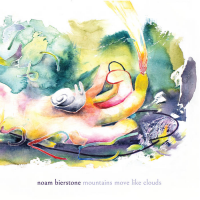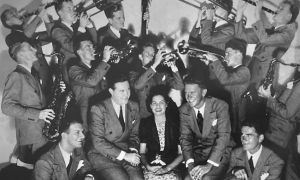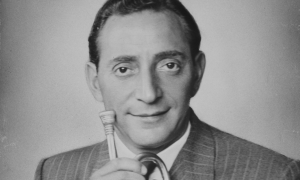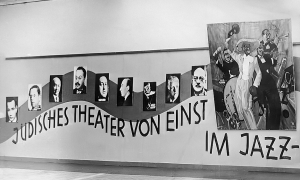Home » Jazz Articles » History of Jazz » Canaries In A Musical Mineshaft
Canaries In A Musical Mineshaft
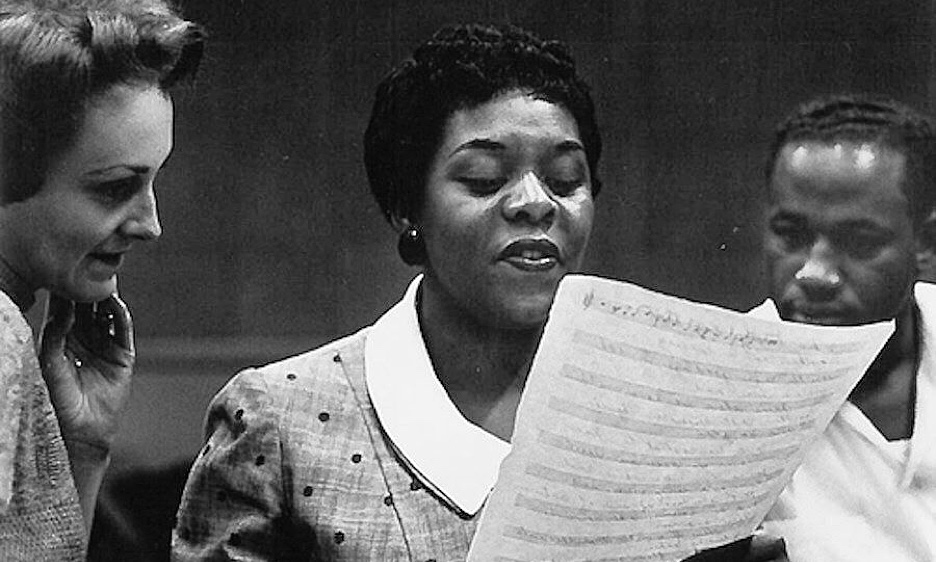
Women, the other hand, were somewhere between Betty Friedan and Kate Millet—-their preassigned role was in the home, and the people who made the rules about their roles were the men. It's hard not to sympathize with this view when you read some of the reviews these singers got. They should probably be tending house anyway, but if they weren't, the boys made the rules. You don't have to be much of a feminist to understand the position was impossible.
If you are a devoted reader of All About Jazz, you just may have heard of Terry Morel. Almost nobody has heard of Donna Brooks. And she is hardly the most obscure of the singers under review here. You may perhaps have heard of Jane Fielding. You never heard of Betty Ann Blake. Funny thing is, some serious aficionados of female vocalists might say they were all pretty good singers. If you think that talent, good looks, the right connections or even a pedigree are all that matter, think again. They were, of course, all women and white as well. You think that mattered?
It is not my intention to attitudinize. This is not that kind of piece. Who doesn't know that plenty of very talented, good looking, connected (in every sense) guys—and not just white ones, didn't make it? Ended up badly, suffered from multiple emotional and substance abuse problems—probably connected—and died forgotten, sometimes by the own hands. No less an authority than Gunther Schuller observed that the unhappy, alcoholic artist—especially a horn player—is something of a trope in jazz. Tragedy seems to be an equal opportunity, if not precisely random fate.
We are today profoundly divided by race and gender. I claim no special expertise or insight into the study of either. My motivation was, naively, less cosmopolitan. I just kept running across all these singers, mostly women, a lot of them white, frequently from the 1950s, whom I had never heard, let alone heard about. And they sounded good. Even critics who seemed to regard their vocation as a blood sport could occasionally admit as much. So, I asked myself, basically, "Why did I hear a lot from x, but nothing from y?" In some cases, by my ears, y was preferred to x. Yeah, I know, popular taste, "the music business," fame is fleeting, all that. But a little bit of collective biography did suggest certain patterns, even if they were evident to me because of bias in selection, confirmation of something that I was predisposed to see and therefore saw. This isn't science or any kind of controlled experiment. It's just jazz, not social theory.
What would you make of the following statement: "[This] is yet another in this year's [1956] seeming avalanche of girl 'jazz' vocalists who do not flow and neither do they weep." Clever, right? On the one hand, the reviewer was certainly correct about the seeming avalanche of "girl" singers in the mid-1950s. People wrote about girls, thrushes, and canaries, or "girl singers" if they were being polite or formal. It was what it was, down to the cheesecake album covers. That said, should we try our hand at a brief list of who might be included? In no particular order, other than alphabetical: April Ames; Mary Lou Brewer; Carole Carr; Ann Greer; Vicky Lane; Ruth Olay; Ruth Price; Ann Richards. That barely scratches the surface. If you have any interest in the subject, you can certainly come up with plenty more, and argue who goes where in the lost to history sweepstakes. Here's a pro tip: look at Bill Reed's The Last Musical Hurrah (Cellar Door Books, 2016). He may not have gotten everyone, but you can't do much better. His special interest is finding singers who made one recording and out. To hear much of this work, and a great deal more, go to Eddie Styles' truly amazing YouTube channel. (Alas, no longer in existence due to copyright restrictions) I'm tempted to say if between Reed and Styles, you cannot find something, it cannot be found, or never existed. Maybe. The singers I look at here are for the most part fortunate enough to have had their work rereleased. That was about my only criterion for selection.
One other thing. This should not be an article, or a blog post. It really should be a book, not to say a serious, inclusive social history. Some writers have already gone in that direction, like Marc Myers, in Why Jazz Happened (Oxford University Press, 2012). I'm thinking more specifically of what was peculiar to women singers, and not just white ones, although you complicate the discourse considerably when you justifiably ask about race or sexuality.
I'm not certain how I stumbled on to Donna Brooks. I had never heard of her. I later found that musicians of her own generation had not heard of her either, which is considerably more unusual. Like Terry Morel, Brooks grew up in an immigrant family near Philadelphia. For a time, she lived in West Philadelphia. Her obit in the Washington Post in 2009 claimed that Brooks received her vocal training at Curtis Institute, but Curtis has no record of it. She may have studied with someone from Curtis. Her given name was Louise Angert, but she was also known as Louise A. Smith after she married her husband, pianist Alex Smith, in New York in 1956. My assumption is that she became known as Donna Brooks when she came to New York in the early 1950s.
One thing is clear. Donna Brooks was a fair singer. While a common theme through the careers of all these women was the harsh treatment they received at the hands of (solely male) critics in the trade press, Brooks was a bit more fortunate. The jibe about "girl" vocalists " who do not flow and neither do they weep" was, unfortunately, directed at Brooks, but when someone could write that an established talent like Rosemary Clooney sounded as if she were "singing through a straw," it was a safe bet that a newcomer would get roughed up. Brooks had previously worked as a production singer at the famous Roxy Theatre and was introduced to jazz by bop accordionist Mat Matthews (with whom she made a now-vanished debut recording on the Venus label). Her first findable recording was on Bethlehem, in 1954 (BEP 104) and it is something. The "A" side is "Gone With The Wind" and "Lullaby of the Leaves." "B" side, "The Things We Did Last Summer" and "What More Can A Woman Do." The band includes Bobby Scott, Chuck Wayne, Milt Hinton, and Bobby Exiner. It brought over $300 on E Bay when it was available, evidence of excess demand for sure. If you have, ears, you can hear why. "The Things We Did Last Summer" is a nice job, for sure, but if you ever heard Doug Mettome play "Gone With The Wind," Brooks has the same effect: swinging beauty tinged by yearning. When Nat Hentoff, who could be brutal, reviewed it for Downbeat (June 1955), he awarded it 3 stars, praised her "respect for the lyrics" and said, "she's easy to listen to and several cuts above most pop vocalists." Getting that kind of treatment from Hentoff was remarkable.
Her recording with Matthews, which I have not located, got the customary treatment from Barry "Miss Anita O'Day should clear her throat" Ulanov, who allowed that Brooks was "hip," but that her singing voice isn't up to it." It could have been a lot worse. The recording that Brooks is known for, and which is still available, is I'll Take Romance and was on the Dawn label (DLP 1105) in 1956. By then, Brooks had married, and the band featured her husband, pianist Alex Smith. The reviewer was not as kind as Hentoff had been. He said Donna had a nice voice—which was an understatement—but didn't really swing and that the band, which included her husband, was competent at best. He wanted her to be a shouter, albeit quietly. My own favorite is Brooks' version of "An Occasional Man," which, mildly risqué as the lyrics were, she cleans up to make it clear that she was not that kind of girl. You'd have to listen, but I've wondered if that doesn't provide a clue as to why she disappeared. As in, "this is a song, but it's not about me." It's hard to say.
In any event, she continued to make appearances. In New York, she had gigs at Café Society (ostensibly, according to Billboard), and Matty's Town Crest, a brash club on 49th Street between 6th and 7th. She went on the road to Chicago, appearing at the Cloister Inn on Rush Street, then a top night spot. These were all high-profile gigs. And then, just as suddenly, she dropped from sight. According to Bill Reed and her obituary, she continued to work with the USO into the 1970s around Washington DC and in military clubs where her husband, Alex Smith, was in a military band. She died in 2010. She supposedly worked in the Catskills as well where she did a Yiddish repertory, but I have searched in vain for any evidence.
So, our Ms. Brooks disappeared, but not exactly. She moved from recording and visibility to distinctly less visible (indeed, well-nigh untraceable) venues. This fact, in conjunction with generally very good reviews, suggests a deliberate decision. Not what economists would call involuntary unemployment. You can speculate all you want about what transpired, but it remains just that: speculation. She was a considerable talent.
Jane Fielding (pictured above with Dinah Washington and Clifford Brown), presumably because she made more than one recording, does not even appear in Bill Reed's collection (although Terry Morel, who also made more than one recording, does). Again, Fielding's recordings are still available, which is little short of a miracle. One of the odd things about Fielding's career is how it parallels Terry Morel's. Fielding was from Lansdale, Pennsylvania, born in 1935. She seems to have also lived for a time in Philadelphia as well, but according to a sympathetic portrait of her by Marc Myers her entire family moved to California in the early 1950s. Unlike Morel, there is no record of her singing around Philadelphia, perhaps because she was not a singer at all, although that's not entirely clear. Like Morel and Brooks, she was very attractive. It is not hard to understand why someone would want to get her in front of an audience. She seems to have attended high school in Southern California doing the usual things that high school students do, including local theater.
By the mid-1950s, Fielding was on her own, living in Los Angeles. She had signed on to make a recording with the Jazz West label, and was part of the jazz scene, dating tenor saxophonist Ted Efantis. Efantis claimed Fielding wanted to marry him. "Fielding asked him for an engagement ring. He bought her a hi-fi stereo. And that was that." Well, Jane recovered, eventually married a Hollywood film production type, had children, and then divorced. Here is a simple trajectory that could account for the relative brevity of her public career. Kids require care, feeding and other basic human needs. In the 1950s, this was women's, if not necessarily a mother's work. By the time Jane passed away in 2000, her ex was in Mexico, but she remained in Southern California, where, according to Marc Myers, she worked in musical theater and did gospel music, among other things.
It's also necessary to keep in mind that while many of us—indeed, most, it seems—think that singers like Morel, Brooks and Fielding were pretty good vocalists, critics in the 1950s could be harsh. They rarely held back. In Fielding's case, her recordings are very well regarded today. People now talk about her easy behind-the-beat phrasing, and her precocious emotional depth. However, their contemporary reception was another matter. Just to clarify why singers like Fielding struggled, I'm going to quote some of the reviews her recorded and live performances got. They could not have helped. Her debut recording (Jazz Trio for Voice, Piano and String Bass) backed by Lou Levy and Red Mitchell got handled relatively gently in Metronome: "resonant voice and fine phrasing almost make up for her still-developing style and intonation problems." Fair enough. I heard the same problems, but have you ever listened, really listened to June Christy, beloved by Stan Kenton?
It's not as if her intonation was invariably perfect. Then there is the Hentoff review in Downbeat (December 1955). "The sound that she does achieve is annoyingly mannered and derivative...It's all too calculated and artificial." Ms. Fielding, you're no Ms. Brooks,
There was a helpful evaluation of Fielding in a Jazz West Coast Concert in Pasadena (1956) featuring Shorty Rogers, Bud Shank, and Bob Cooper, among others. John Tynan, well known for his openness to new things (see his take on John Coltrane and Eric Dolphy as "antijazz") opined: "Weakest note of the evening was sounded by Miss Fielding. While her approach to jazz singing might be debateable (sic) her phrasing and intonation are hard to take. Overstressed and affected vocal mannerisms such as she exploits add up to an invalid passport even to the land of Ooo-bla-dee." Then came one Douglas Watt in the New York Daily News who opined Miss Fielding "a pretty thing...also thinks she sings...attempting to use her voice as one more jazz instrument...succeeds only in dispensing corn in flat, unmusical tones..."
Can you imagine? One more jazz instrument? In a nutshell, that was the problem. Fielding had never been a band singer and she didn't sound like one. While people said her timbre was of the dark side, it was just the opposite. She was light and with a very quick, narrow vibrato. Sound familiar, like the goal of a lot of first-generation boppers, including Miles Davis, or, to stretch it, Lester Young? There was none of the emphatic, syllabic style that easily identifies the 1930s and 1940s "canaries." Fielding was ahead of the critics—no surprise—and she wasn't established enough to get away with it. Another pretty face? No, wrong.
Try as I might, I could find no reviews of public performances or evidence of recording after these deep insights. Once again, a real talent fell between the cracks. True, they reflected only a few opinions, but there was then no alternative to newspapers or the trade press.
Fielding's second recording, Embers Glow, sounds quite different. If there are intonation problems, they are not evident; Fielding sounds altogether much more confident. Her repertoire includes "Key Largo" and "Round Midnight." Not that some learning-by-doing should be surprising if you're 22 years old. You get the impression that Fielding may have been impulsive and rushed into things with a minimum of preparation. Perhaps her first recording. Or maybe life.
So, we come to our final example, Betty Blake. Who? Yes, Betty Blake. Well, she didn't start out as Betty Blake even Betty Ann Blake. Her given name was Elizabeth Baldrick, and she was born in Cincinnati in 1938. Her first bandleader told her Baldrick was not a proper name for a chanteuse. By consulting a phone book, briefly, they came up with Blake. Like most singers, she started out in high school, Hughes High, where she was the "girl singer" in the Dance Band, whose "boy singer," George Dupree , became her husband for a while. She paid her dues singing locally, probably on weekends at the Spa Room at the Kemper Lane Hotel and ended up singing for three years with Buddy Morrow (1956-1958).
"It's a lot of fun at first," Blake said of life on the road, "but slowly begins to wear down." Apart from the usual stuff about one nighters and lousy food, Blake pointed out that the girl singer had to "hold [her] wardrobe down, too." And keep her hair fixed as well. Appearance, for her male bandmates, was undoubtedly a secondary consideration. Eventually she got off the road and went back to Ohio, where she tried domesticity for a while in the 1960s. That apparently did not work out. But ironically, although her obituary retained her married name, it made no mention of her career as a singer, even though she told a hometown interviewer after leaving Morrow she had no regrets. There are inevitably a lot of puzzles, lots of hints at the personal toll that the music business took on even its most successful practitioners. It looks as if Betty held down a weekend gig on a river cruise boat named "Betty Blake" (I am not kidding) that featured trad jazz. Maybe it was her boat! In any event, that lasted until 1984. Betty died in 2001.
Ok, so what about her music? It's very likely that only a very small set of people have ever heard of Betty and her 1961 Bethlehem recording, Sings in a Tender Mood (BCP-6058), let alone her work with trumpeter John Plonsky's Quintet. The review (November 1961) speaks for itself, more or less. "Betty Blake...Uncomfortable, nervous, flat, un-musical singing—much like Chris Connor on a very bad day." Of the outstanding band and choice of material: "Great tunes plus great musicians do not a singer make." The review absolutely baffles me. Reviews are hard to write under the best of circumstances. There are going to be people whose playing you just don't warm to, or, conversely, you may hear something in someone's music that escapes others. That's true of all art, isn't it? I'm not sure what the aesthetic criteria for simple fairness are, but if this characterization meets them, I don't know how. Blake may not be my favorite singer. I may prefer Donna Brooks, or Jane Fielding, or Terry Morel, or any number of others, but this one is about as close to defamatory as you can get. Her intonation is no worse than many others, and better than quite a few. Her articulation and delivery are straightforward, and if someone just played "While We Were Young," "How About You," or "Let There Be Love" cold, my reaction would probably be on the order of "Nice voice, swings, expressive, good band. She can sell a song. I'll happily listen to more." Yeah, the Chris Connor-June Christy school, but so what? If I hadn't read some of the things that critics wrote about other jazz musicians in the 1950s, I'd be shocked.
Unfortunately, Blake just got the standard treatment, albeit considerably worse. Jordi Pujol's liner notes observes "she disappeared from the scene and there were (sic) no further news from her professional activities." Not really an exaggeration, but would anyone really wonder why? Listen for yourself. If you're reading this, you're interested and have ears. I'm not certain what was going on. Blake was treated very shabbily. We'll leave it that.
We started out in 1955 and we're going to close out in 1956. No, this isn't an arbitrary date. Elvis Presley, at 21, made his debut on the Ed Sullivan Show. Of the top 100 pop singles that year, Elvis had six. Nat King Cole had two. Frank Sinatra had one. Tommy Dorsey died in his sleep. And a lot of pop careers went with him. Janet Brace, another fair singer who went one and out in the recording arena (her album Special Delivery was released in, oh, oh, 1956) said "rock and roll killed her career." I wonder if she meant Elvis or or Fabian? Rosemary Clooney, whom many will know from her late career comeback and her series of recordings for Concord Jazz, had a similar insight. After early chart toppers like "This Old House" or "Hey There," her career flatlined for years. It wasn't just rock and roll in Rosie's case—a lot of other personal stuff was going on—but here's what she's says about rock 'n roll: "A new generation of teenagers...was coming along. When I was a kid, we listened to grown-up music and bought grown-up records...They had their own money...their own market...and weren't interested in standards." They bought Elvis. They didn't buy Sinatra. Don't blame the Boomers (as, amusingly, Mitch Miller, a major recording executive did). The average one would have been about 10 years old in 1956. These were, presumably, War Babies. Between the Greatest Generation and the Biggest Generation. I, a Boomer, had no independent income then; nor did I tell my Father what music to purchase.
Of course, it wasn't simply rock and roll that derailed lives and careers. It would be nice if everything were so simple. But this was America in the 1950s. If you wonder why the 1960s witnessed a veritable social revolution, it's worth considering what people were pushing against. The sort of Procustean bed of race and gender roles for which the Vietnam War was such a challenge—the structure of authority in a larger sense—came up against an unparalleled expansion of the postwar economy. If you think the Big Bands got slaughtered by changing times, you're right, but perhaps not in the way you're accustomed to thinking. Without turning this into an economic exercise, prosperity killed them. It's a well-known phenomenon in economics. It's called Baumol's disease. Without totally going nerd, a rising tide of income lifts all boats—except the ones that won't float. Those sink. The bands, the incubators of so many singers' careers—both girl and boy alike—became unaffordable precisely because rising wages in America made picking up a horn, or hiring a horn player, a much more expensive proposition. Forget what they did to people's expectations and horizons, or to their conception of exactly where they fit in a prospering society. That, of course, mattered too, but perhaps in ways that no one precisely expected. Yes, traditional sex roles were tough on men. No one is disputing that
Women, the other hand, were somewhere between Betty Friedan and Kate Millet—their preassigned role was in the home, and the people who made the rules about their roles were the men. It's hard not to sympathize with this view when you read some of the reviews these singers got. They should probably be tending house anyway, but if they weren't, the boys made the rules. You don't have to be much of a feminist to understand the position was impossible. Rosemary Clooney embodied it, with five children at home, and Mitch Miller at Columbia calling the shots. "I recorded a lot of crap," I heard Rosie say at the Rainbow Room in 1998, but crap kept her children eating while Joe Ferrer did whatever he pleased. It was an impossible position. With Clooney, it led to a breakdown. The others, like Brooks, Fielding, Blake and how many more, simply disappeared. You could blame rock, American society, or a business model that gave lots of singers a shot but had no incentive to push their careers along. These are painful realities. Unlike baseball, most studios had no reserve clause. Ironically, it might have been better for the unsuccessful artists if they had.
The recording industry itself played a big part in the one and done phenomenon. In 1958, Oscar Hammerstein II told a congressional committee, "No song can be popular today unless it is sung on television or radio. The basic source is the phonograph record. After an attractive record is made of a song, it is then sent to the disk jockeys who work on the radio and television stations. This is how popular songs are launched and exploited all the way up to the Hit Parade." The first mostly jazz stations came on the air in the late-1950s in large urban markets like Philadelphia, San Francisco, Chicago, and New York. Disc jockeys made or broke songs by what they played. It is much of a stretch to think what showed up in the trade press had some effect on what they were willing to put on the air, especially during a changing market? Aside from fans, who else read toxic reviews?
These were also the payola years, when disc jockeys in major markets got substantial financial incentives to play tunes from song pluggers. Many of the jazz labels, of course, were barely solvent. It is hard to believe they would have the wherewithal to push an unknown singer even if they had so desired. Since there were jazz radio personalities caught up in payola, it happened sometime. The idea that a Brooks, Blake, or Fielding would have been the object of a concerted promotional campaign is, nevertheless, to put it mildly, implausible. Mitch Miller, who could make and break careers at Columbia, was pushing Rosemary Clooney, who had already been an established band singer, not to say a television personality. When singer Johnny Hartman broke through, it was because Harvey Husten a jazz impresario in the Philadelphia area, put his music on the air. But even Husten could only do so much. He clearly liked Terry Morel and wrote her liner notes for Bethlehem; her career basically went nowhere. You have the feeling that a lot of singers got one shot. If they didn't catch on the first time, there were plenty of others to take their place. Look at the list of good female singers disappeared. If not excess supply, then what? As Michael Steinman reminded me, Pat Kirby, about whom he has written extensively in his blog, was yet another Philadelphian in the early 1950s who had made it, at least as far as appearing on Steve Allen (with Andy Williams, Edie Gorme and Steve Lawrence). Steinman emphasizes she simply quit abruptly and seemingly disappeared. Skitch Henderson, the music director of Allen's program, said "she had no illusions about stardom." She went home (actually, Cherry Hill,New Jersey) to raise a family.
If you've ever read Lope de Vega's classic drama, Fuenteovejuna (1476) you might remember an entire Castilian town assumed the guilt for killing a tyrannical royal official: "Fuenteovejuna did it." Well, maybe we come to a similar answer about who killed all the canaries in the musical mine shaft in the 1950s. Everything, everyone, nothing, and nobody. The system killed them. It's almost a cliché, but there's no better answer. Unless you have one.
Tags
History of Jazz
Richard J Salvucci
Donna Brooks
Jane Fielding
Terry Morel
Ann Richards
Ruth Price
Betty Blake
Dinah Washington
PREVIOUS / NEXT
Support All About Jazz
 All About Jazz has been a pillar of jazz since 1995, championing it as an art form and, more importantly, supporting the musicians who make it. Our enduring commitment has made "AAJ" one of the most culturally important websites of its kind, read by hundreds of thousands of fans, musicians and industry figures every month.
All About Jazz has been a pillar of jazz since 1995, championing it as an art form and, more importantly, supporting the musicians who make it. Our enduring commitment has made "AAJ" one of the most culturally important websites of its kind, read by hundreds of thousands of fans, musicians and industry figures every month.


